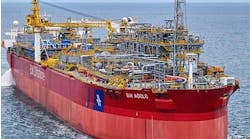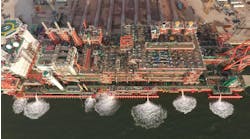Gene Kliewer • Houston
Valiant Causeway has submitted a development plan to the UK government for the Causeway field in the northern North Sea. The plan calls for one new production well and a water injector in the East and Far East fault panels. Development also will use existing wells drilled during the appraisal phase. Technip has a letter of intent for the main subsea installation contract.
Causeway is being developed using subsea production technology with a tieback to the existing North Cormorant platform. The reservoir development strategy is to maintain production using electrical submersible pumps (ESPs) and water injection. The Causeway field will comprise one oil-producing well, one contingent oil-producing well, and one water- injection well.
First oil is likely in mid- 2012. Hydrocarbons will go to the TAQA Bratani-operated Cormorant North platform before being exported to the S0ullom Voe terminal on Shetland.
Causeway is in UK block 211/22a South West Area and block 211/23d. The development has an estimated 8.9 MMbbl of proved plus probable oil reserves in the East and Far East fault compartments, says Valiant. The development plan includes an option to produce reserves in the Central panel.
GE to supply subsea equipment for the Causeway field
GE Oil & Gas will provide subsea production equipment for the Causeway field. This equipment includes two subsea production trees, one subsea water injection tree system, rental tooling, and installation services. The equipment will be manufactured at GE Oil & Gas facilities in Aberdeen, Scotland.
"We are committed to commence production in the second half of 2012, and installation of the subsea tree system is planned to begin in May of 2012," said Bryan Atchison, project manager of Valiant Causeway. "This is a very aggressive schedule and a close working relationship has been established between GE and Valiant to ensure that we are able to meet all of the project requirements."
According to partner Antrim Energy, approval should come through from the Department of Energy and Climate Change before year-end.
Kikeh to expand subsea
Aker Solutions has secured a contract with Murphy Sabah Oil Co., Ltd. to deliver a subsea production system for the Kikeh subsea expansion project off the coast of Sabah in East Malaysia.
Aker Solutions will deliver deepwater oil production equipment such as subsea trees, control modules distribution system and manifolds that will be installed at a water depth of 1,350 m (4,430 ft).
The project will be delivered out of Aker Solutions manufacturing center in Port Klang, Malaysia. The subsea hardware is expected to be on production in 2013.
Dave Hutchinson, president, subsea Asia Pacific at Aker Solutions said: "We are extremely pleased to have Murphy as our returning customer. We will deliver a quality project fully utilizing our experience in the region."
Jack/St. Malo moving forward
First Subsea has been awarded a contract by Chevron U.S.A. Inc. to supply the mooring connectors for the semisubmersible hub production facility at Jack and St. Malo fields 280 mi (450 km) in the Gulf of Mexico south of New Orleans in water depths of 2,133 m (approx. 7,000 ft).
The semisubmersible FPU will be moored by 16 Ballgrab, ball and taper, mooring connectors attached to polyester mooring lines in a 4 x 4 arrangement. Ballgrab says the Series III male connectors will be the largest produced so far with an un-corroded 2,599 mT (25,491 kN) MBL, and will be the first to comply with the new ABS Mooring Guide 2009.
The female connector will be installed subsea with the mooring system's suction piles, mounted on docking porches. When the FPU is in position, the male connector, attached to the mooring line, will be lowered from the surface into the female receptacle to complete the mooring installation.
Galoc Phase II FEED gets go-ahead
The Galoc Production Co. reports that the joint venture has approved going ahead with the front-end engineering and design (FEED) for Phase II and also the acquisition of new 3D seismic data.
The purpose of the FEED is to determine the number of added wells to be drilled and where they will be drilled. Drilling is expected to be in 2013. The FFED also will include modeling of the reservoir, subsea engineering, and a tieback design for the new wells.
The final project approval, Final Investment Decision ("FID"), for the Galoc Phase II development is targeted for mid-2012. The Galoc Joint Venture says it will consider pre-investment in required infrastructure, including wellheads, flowlines, and umbilical lines during the FEED stage.
The survey approval is for 184 sq km (71 sq mi) of new 3D seismic data over Galoc field and the adjacent Galoc North prospect. The survey is set for October with the inversion and interpretation done by the middle of 2Q 2012.
Otto currently owns an 18.78% holding in Galoc through GPC. Otto has entered into an agreement to increase its interest to a direct 33.00% in Galoc, including 100% ownership of GPC, and to assume control of the operator of the field. Completion of the agreement is scheduled to occur prior to 30 September 2011.
Otto's Acting CEO Matthew Allen said, "These two approvals are key steps in the Phase II development of the Galoc Oil Field which we are currently on track to sanction in mid-2012. Given Otto's recent agreement to assume control of the operator and become the largest shareholder in Galoc, the development of Phase II is a core focus for Otto and we are very pleased with progress to date."
Subsea technology taps into outer space
Chevron Corp. and NASA's Jet Propulsion Laboratory (JPL) have allied to develop technologies to improve the production and recovery of oil and natural gas resources.
The alliance's initial focus is to develop technologies – including power transmission, signal processing, and electrical actuation – for application in deepwater.
"NASA and JPL are highly acclaimed national treasures, and Chevron is proud to collaborate with them to unlock new energy potential," said John McDonald, Chevron's corporate vice president and chief technology officer. "This alliance is an opportunity to bridge public- and private-sector technology and research to discover oil and natural gas volumes that are found in deep remote reservoirs. In many ways, the research is akin to deep space exploration, making the missions of our two organizations highly complementary."
"We are proud that the same pool of talent that sends rovers to Mars, explores our universe and studies Earth's environment will help contribute advanced technology towards our energy future here on Earth," said Dr. Charles Elachi, director of JPL.
Technology developed by JPL for interplanetary missions is expected to help gain a better understanding of the geology of Earth. For example, JPL developed technology that enables electronic communication over millions of miles in outer space. That same technology may work in deepwater energy operations, which extend thousands of feet below the surface of the ocean and also encounter extreme pressures and temperatures.
More Offshore Issue Articles
Offshore Articles Archives
View Oil and Gas Articles on PennEnergy.com


